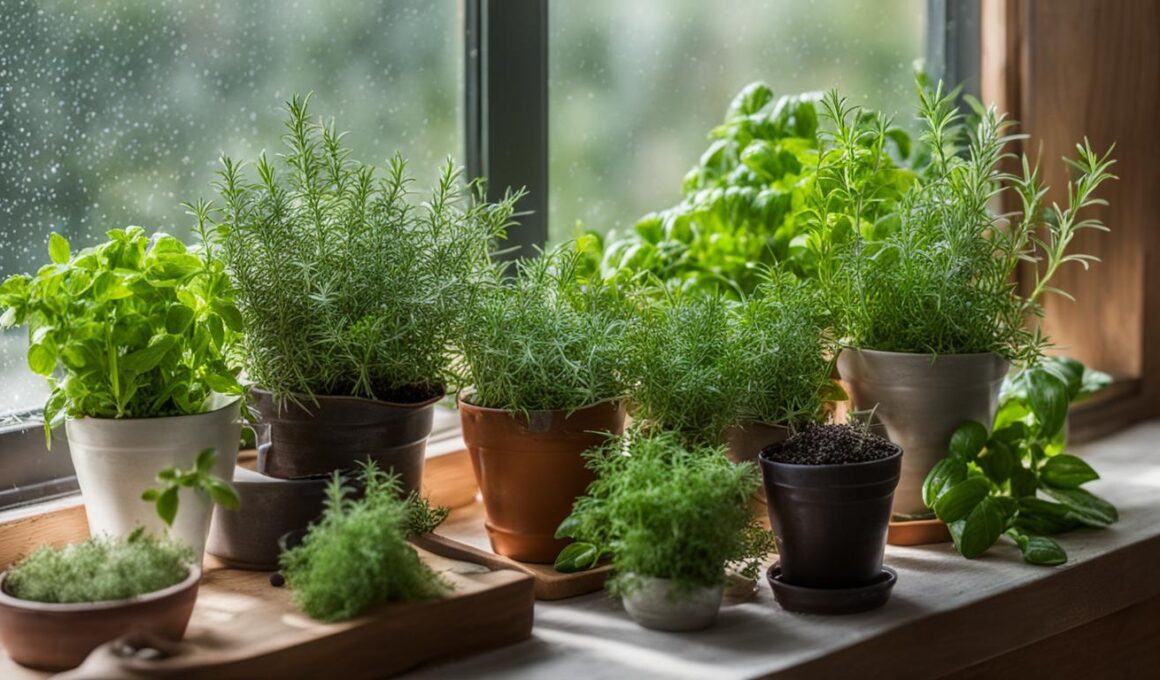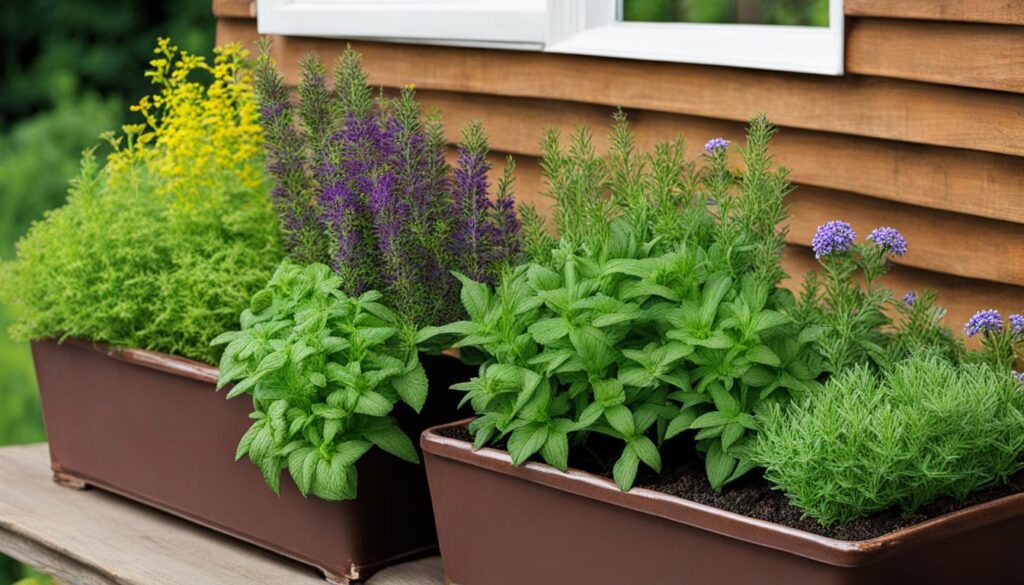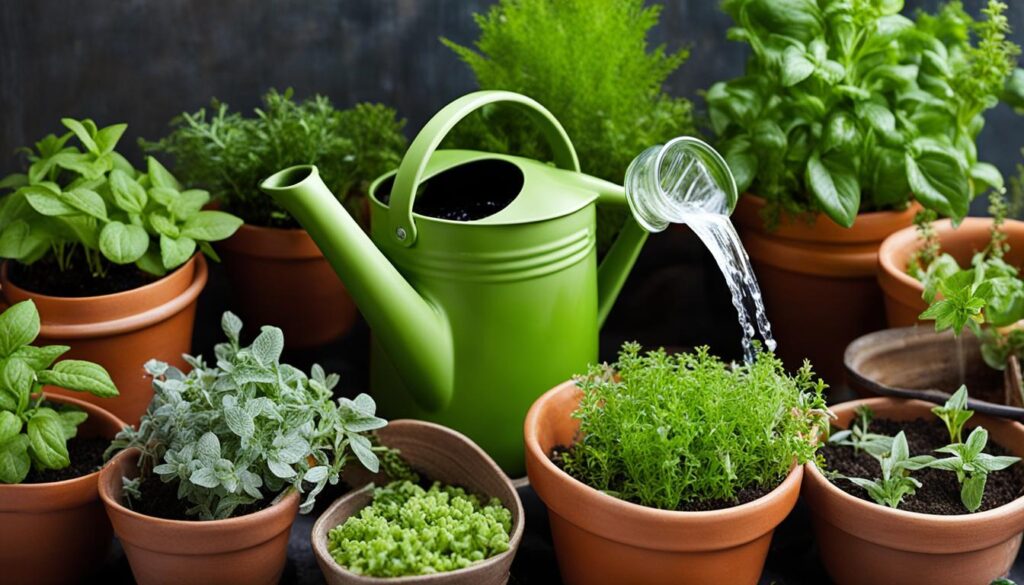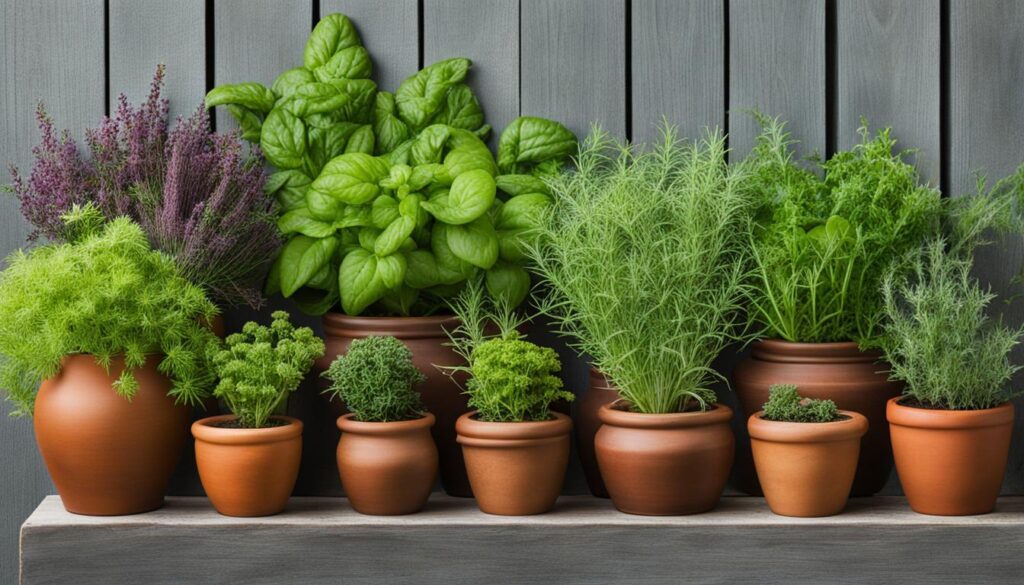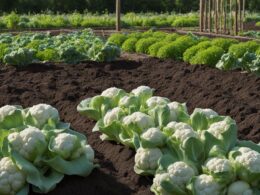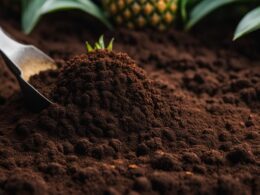When it comes to growing herbs, having them in containers near your home is a convenient and accessible option, especially when you’re cooking. Whether you have limited space or simply prefer the flexibility of container gardening, growing companion herbs in containers can be a rewarding experience.
When choosing herbs for container planting, it’s important to consider the difference between annual and perennial herbs. Annual herbs, such as basil and cilantro, are planted and harvested in the same year, while perennial herbs, like chives and oregano, can survive multiple years, providing you with a continuous supply of fresh herbs.
Another crucial consideration is the water needs of the herbs. Some herbs require more water than others, and planting herbs with similar water requirements together can simplify your watering routine.
The size of the pot is also important. Taller herbs, like rosemary, will need a deeper pot to accommodate their growth. On the other hand, herbs in the mint family, such as peppermint and oregano, may eventually outgrow their pots and need to be repotted into larger containers.
Companion planting herbs in containers can be a wonderful way to create harmonious combinations. Lemon balm, marjoram, and stevia can thrive together, as can oregano and basil. With careful planning, you can find the perfect combinations that suit your preferences and the growth habits of the herbs.
Finally, when arranging herbs in your container garden, it’s essential to consider their growth habits and provide appropriate spacing. This ensures that each herb receives adequate sunlight and room to flourish.
Key Takeaways:
- Choose between annual and perennial herbs based on your gardening goals and desired harvest.
- Consider the water needs of your herbs and group them accordingly to simplify watering.
- Select the appropriate pot size for your herb’s mature size and growth habits.
- Explore companion plantings to create harmonious combinations and maximize your herb garden’s potential.
- Ensure proper spacing and arrangement to optimize sunlight exposure and airflow.
Annual vs. Perennial Herbs: Choosing the Right Herbs for Containers
When it comes to growing herbs in containers, choosing the right herbs is essential for a successful garden. One important consideration is whether to plant annual or perennial herbs. Annual herbs, such as basil, dill, and cilantro, are planted and harvested in the same year. These herbs are perfect for gardeners who want to enjoy a bountiful harvest within a short period. On the other hand, perennial herbs, like chives and mint, can survive multiple years, providing a continuous supply of fresh herbs over time.
Understanding the difference between annual and perennial herbs is crucial in selecting herbs that can be planted together in containers. While annual herbs offer the advantage of quick results, perennial herbs provide long-term enjoyment. However, it’s worth noting that some perennial herbs can be aggressive or spread over time, so it’s important to consider their growth habits and choose wisely.
Key points:
- An annual herb grows and completes its life cycle within a year.
- A perennial herb can survive for multiple years, depending on the garden zone.
- Consider growth habits and potential aggressive spreading when choosing perennial herbs for containers.
“Whether you opt for annual or perennial herbs, both offer unique advantages and flavors for your culinary adventures. The choice ultimately depends on your preferences and the space you have available in your container garden.”
Annual Herbs: Burst of Flavor and Quick Results
Annual herbs are a popular choice for many gardeners due to their fast growth and vibrant flavors. They offer a burst of freshness and can be harvested within a few weeks to a few months, depending on the herb. Basil, with its distinct aroma and versatility in various dishes, is a beloved annual herb for container gardening. Its bright green leaves and delicate taste make it a staple in Italian cuisine and a great addition to salads and pesto. Other annual herbs like dill and cilantro are known for their unique flavors and their ability to elevate the taste of dishes.
Perennial Herbs: Long-Term Pleasure
Perennial herbs are a fantastic choice for gardeners looking for herbs that will return year after year. Chives, with their delicate onion-like flavor, and mint, known for its refreshing and cooling properties, are popular perennial herbs for containers. These herbs not only offer flavorful additions to your culinary creations but also provide a visually appealing container garden with their lush foliage and vibrant colors. The versatility of perennial herbs allows you to enjoy fresh herbs in your cooking without having to replant every year.
In conclusion, whether you choose to grow annual or perennial herbs in containers, both options offer unique benefits and flavors. Annual herbs provide quick results and a burst of flavor, while perennial herbs offer long-term pleasure and continuous harvests. Consider your preferences, space available, and growth habits when selecting herbs for your container garden, and enjoy the convenience and satisfaction of having fresh herbs at your fingertips.
Considerations for Watering Companion Herbs in Containers
Proper watering is crucial for the health and success of companion herbs in containers. Each herb has its own water requirements, so it’s important to understand and meet their specific needs. While some herbs like oregano and peppermint in the mint family require more water, others may only need a moderate amount.
When companion planting herbs in containers, it’s beneficial to group together herbs with similar water needs. This ensures that all the herbs in the container receive adequate moisture without over or under watering. For example, lemon balm, marjoram, and stevia can be planted together as they have similar water requirements.
However, one herb that requires special attention is mint. Mint can be quite aggressive and may take over the container if planted with other herbs. It is recommended to give mint its own container to prevent it from overpowering and outcompeting other companion herbs.
Watering Tips for Companion Herbs in Containers:
- Check the moisture level of the soil regularly by inserting your finger into the soil up to the second knuckle. If it feels dry, it’s time to water the herbs.
- Water the herbs thoroughly until you see water coming out of the drainage holes at the bottom of the container. This ensures that the water reaches the roots of the herbs.
- Avoid overwatering the herbs, as this can lead to root rot and other issues. It’s better to underwater slightly than overwater.
- Consider using a self-watering container or adding a water reservoir to the bottom of the pot to provide a consistent water supply to the herbs.
- Take note of any specific water requirements for each herb and adjust your watering schedule accordingly.
By considering the water requirements of companion herbs and practicing proper watering techniques, you can ensure the health and vitality of your herbs in containers. Remember to monitor the moisture level regularly and provide adequate water based on the needs of each herb. With proper care, your companion herb container garden will thrive and provide you with fresh herbs for all your culinary endeavors.
Choosing the Right Pot Size for Companion Planting Herbs
When it comes to companion planting herbs in containers, choosing the right pot size is essential for their growth and development. The size of the pot should be based on the mature size of the herbs and their growth habits. Taller herbs like rosemary or thyme require deeper pots to accommodate their roots and provide stability. On the other hand, low-growing or trailing herbs can thrive in shallower pots.
For annual herbs, a 12-inch pot is typically sufficient to support their growth throughout the season. However, perennial herbs, especially those in the mint family, may need a larger pot or even their own container. Aggressive perennial herbs like oregano can quickly outgrow their initial pot and may require repotting into a larger container to ensure they have enough space for their roots to spread.
Consider the eventual size of the herb and its growth habit when selecting a pot size. One way to determine the appropriate pot size is by reading the plant tags or researching the specific needs of the herb. By providing the right pot size, you can create an environment that promotes healthy growth for your companion planting herbs.
Growing Tips:
- Choose a pot size based on the mature size and growth habit of the herb.
- Taller herbs like rosemary and thyme require deeper pots.
- Low-growing or trailing herbs can thrive in shallower pots.
- For annual herbs, a 12-inch pot is generally sufficient.
- Perennial herbs in the mint family may need larger pots or their own containers.
- Repot aggressive perennial herbs like oregano into larger containers as needed.
“Choosing the right pot size is crucial for companion planting herbs in containers. By providing adequate space for their roots and considering their mature size, you can create an environment that encourages healthy growth.”
Examples of Companion Planting Herb Combinations
When it comes to companion planting herb combinations in containers, there are several options that can work well together. These combinations not only provide a visually appealing arrangement but can also offer benefits such as improved pest control, enhanced flavor, and overall better growth. Here are a few examples:
- Lemon Balm, Marjoram, and Stevia: These herbs complement each other both in terms of flavor and growth habits. Lemon balm, with its citrusy aroma, pairs well with the sweet taste of stevia, while marjoram adds a savory element to the mix.
- Thyme and Parsley: Thyme and parsley make a classic pairing in both culinary and companion planting. Thyme’s low-growing habit provides a beautiful backdrop for the taller parsley, creating an attractive and functional arrangement.
- Oregano and Basil: Oregano and basil are not only compatible in terms of growth and water requirements but also enhance each other’s flavors. Oregano’s earthiness complements the sweet and slightly peppery taste of basil.
- Sage and Chives: Sage and chives are well-suited companions in containers. Sage’s upright growth habit contrasts nicely with the cascading nature of chives, creating an eye-catching display.
Additional Tips:
When planning your companion planting herb combinations, it’s important to consider the growth habits and overall needs of each herb. Here are some additional tips to keep in mind:
- Choose herbs with similar water requirements to ensure consistent watering practices.
- Vary the heights of the herbs in your container garden, placing taller herbs towards the back and trailing or low-growing herbs towards the front.
- Consider the flavors and aromas of each herb to create complementary combinations that enhance your culinary creations.
Companion planting herb combinations in containers not only add beauty to your garden but also offer several benefits. By selecting herbs that complement each other in terms of growth habits, flavor profiles, and water requirements, you can create harmonious combinations that thrive together. Take advantage of companion planting to maximize the potential of your potted herbs and enjoy an abundant and flavorful herb garden.
Plant Spacing Requirements and Arrangement for Companion Herbs in Containers
Proper plant spacing and arrangement are essential for the successful growth of companion herbs in containers. Consider the growth habits of each herb and provide adequate space for them to thrive. While plant tags may provide spacing guidelines, it is crucial to take into account the mature size of the herbs to prevent overcrowding.
When arranging the herbs in a container, strategically place taller herbs towards the back and trailing or low-growing herbs towards the front. This arrangement ensures that all herbs receive proper sunlight exposure. Remember that sunlight requirements may vary for different herbs, so it’s important to choose the right location for your container garden.
Creating an organized and visually appealing arrangement can also enhance the overall aesthetic of your container garden. Consider incorporating complementary colors, textures, and shapes to create an attractive display. Adding decorative elements, such as rocks or small garden ornaments, can further enhance the visual appeal of your herb container garden.
Regular pruning and maintenance are crucial for managing the growth of your herbs in containers. Pruning helps to control the size of the plants and promote better airflow, reducing the risk of disease. Additionally, removing any yellowed or damaged leaves helps to maintain the overall health and appearance of the herbs.
Key Points:
- Provide adequate spacing based on the mature size of the herbs.
- Arrange taller herbs towards the back and trailing or low-growing herbs towards the front.
- Consider sunlight requirements when choosing the placement of your container garden.
- Create an attractive display by incorporating complementary colors, textures, and shapes.
- Regular pruning and maintenance are essential for managing herb growth and maintaining overall health.
Proper spacing and arrangement of companion herbs in containers not only support their individual growth but also contribute to the overall aesthetic appeal of your container garden. By taking into account the growth habits and mature sizes of different herbs, you can create a harmonious and visually pleasing arrangement that ensures each herb receives the necessary sunlight and space to thrive.
Conclusion
Growing potted herbs is a fulfilling endeavor that brings the joy of herb gardening right to your doorstep. With the right approach and considerations, you can successfully cultivate a thriving container garden filled with fresh and aromatic herbs.
By carefully selecting herbs based on their growth habits, water requirements, and pot size, you can create harmonious combinations that will flourish in your containers. Each herb has its own unique needs, so it’s important to pay attention to their specific requirements and make adjustments as necessary.
With proper care and attention, your potted herbs can last for multiple seasons, providing a beautiful and practical addition to your garden or indoor space. So, roll up your sleeves, get your hands dirty, and enjoy the satisfaction of nurturing your own herb garden in containers.
Can I Use the Same Containers for Growing Vegetables and Companion Herbs?
Yes, you can use the same containers for growing vegetables in pots and companion herbs. This practice is called companion planting, and it can enhance the growth of both types of plants. Just make sure the container is large enough to accommodate the root systems of all the plants.
FAQ
What is the difference between annual and perennial herbs?
Annual herbs are planted and harvested in the same year, while perennial herbs can survive multiple years.
Do herbs in containers require different amounts of water?
Yes, some herbs require more water than others. Herbs in the mint family, for example, require more water.
How important is the size of the pot when growing herbs in containers?
The size of the pot is important as it should be deep enough to accommodate the mature size of the herb.
Can different herbs be planted together in the same container?
Yes, many herbs can be companion planted together in containers, but it’s important to consider their growth habits and water needs.
How should herbs be arranged in a container for proper sunlight exposure?
Taller herbs should be placed towards the back of the container, while trailing or low-growing herbs should be towards the front to ensure proper sunlight exposure.
How long can potted herbs last in containers?
With proper care and attention, potted herbs can last multiple seasons.





